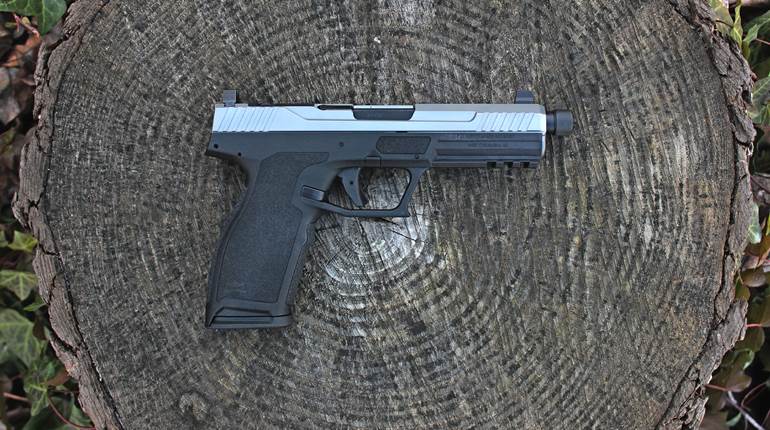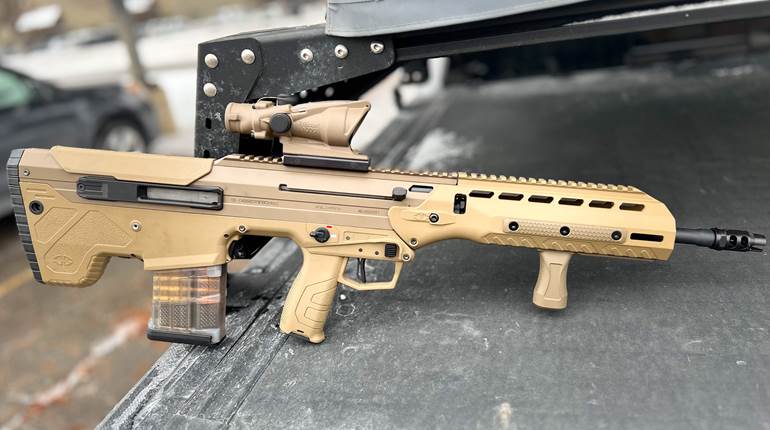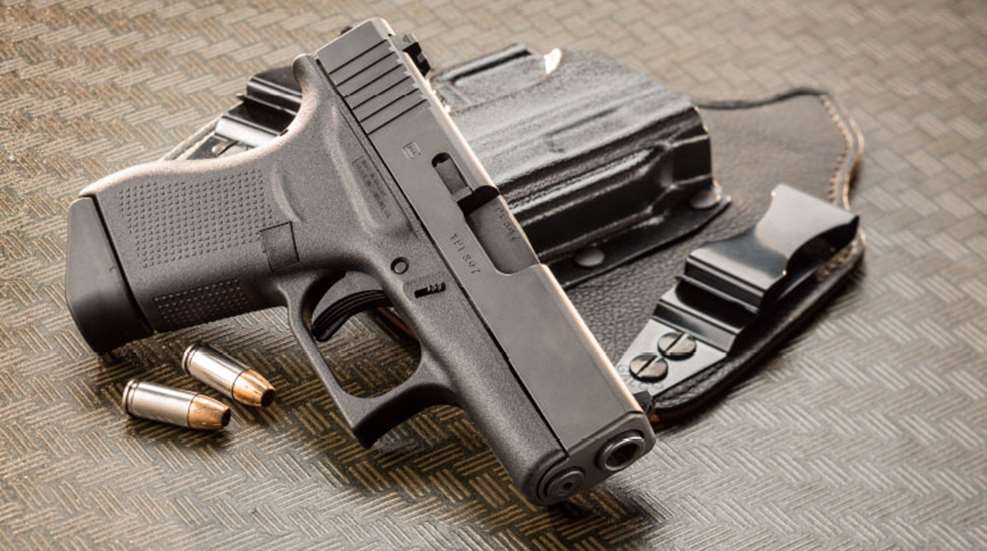
Compact 9 mm Luger pistols designed specifically for concealed carry are nothing new. But sometime around the start of this decade, a growing segment of the self-defense market began demanding single-stack 9 mm pistols that are even easier to carry and conceal. Such pistols offer a flat profile and small footprint comparable to the now-ubiquitous pocket .380s but with a level of stopping power on par with the standby J-frame revolver in .38 Spl.
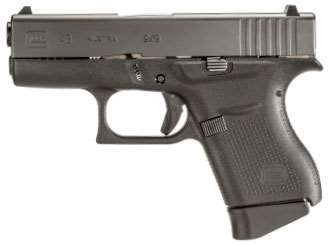
If the current trend of single-stack 9 mm pistols was not actually jump started by Ruger’s release of the LC9 pistol in 2011, then it was at least a good, strong shove in the right direction. Other manufacturers, including Taurus, Smith & Wesson and Springfield, have all jumped aboard the single-stack train, while companies that already had narrow 9 mms in their catalogs, such as Kahr and Kel-Tec, have been able to sit back and enjoy the ride.
But where was the company that originally established the polymer-frame, striker-fired pistol as a viable, popular defensive option in the first place? Where was Glock? With more than two decades of history under its belt, Glock has earned a reputation for being one of the top providers of combat pistols around the world. Although Glock has historically relied on military and law enforcement contracts to keep its bread buttered, the company seems to be taking a greater interest in meeting civilian demands these days. Last year the pocketable G42 .380 ACP arrived on the market—also noticeably late. This year the company is launching optics-ready competition models, a 10 mm Auto for hunting and the long-awaited G43 single-stack 9 mm, which is the subject of this story.
Pistol Features
Like the rest of the pistols in Glock’s catalog, the G43 is a polymer-frame semi-automatic. Manufactured in Austria and imported through the company’s Smyrna, Ga., facility here in the United States, the gun has external dimensions that fit squarely between the diminutive G42 .380 ACP and the double-stack G26 9 mm. As for its appearance and layout, the G43 is essentially a slightly larger G42.
The pistol tips the scales at slightly less than 18 ozs. with an empty magazine installed. Its overall length is 6.26" with a height of 4.25" at the rear sight when a flat-based magazine is installed. This gun is listed as being 1.02" wide, but the only point on it that is actually 1.02" is at the slide lock. The slide itself is only 0.87" wide, while the frame is between 0.90" and 0.92" depending on the location.
Although the gas-nitrided steel slide is narrower than those of the double-stack models, it has the familiar square shape and matte-black finish for which Glocks are known. Unlike some of the more recent slides, which are beveled at the muzzle, this one has the square nose of earlier generations. A set of straight, wide serrations at the rear of the slide aids in purchase. The 3.39" barrel contains hexagonal rifling, which means the use of unjacketed lead bullets should be avoided. The extractor is shaped to act as a visible and tactile loaded-chamber indicator.
The sights are of the Glock standard variety. The system consists of a polymer white dot unit in front and a drift-adjustable, polymer white outline notch unit in the rear. The G43 contains the same striker ignition system, short-recoil operated locked-breech barrel and Safe-Action trigger found in other Glocks. The Gen4 recoil assembly is fitted with dual recoil springs, a polymer guide rod and steel supports in key locations. Like the smaller G42, it has an enlarged firing pin safety plunger with an irregular, beveled surface.
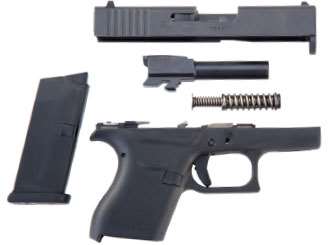
The slide lock, magazine release and take-down lever have been lifted from the Gen4 pistols and can be found in their usual locations. The magazine release button is reversible for left-handed shooters. A raised ridge on the left side of the frame protects the slide catch from being inadvertently bumped up into slide lock by the shooting hand thumb during recoil (a problem that cropped up for some shooters when using the smaller G42).
The spacing within the trigger guard and the trigger itself are the same as the double-stack models. This creates a familiar feel for those who already use Glocks. The trigger stroke is typical Glock, with a slightly mushy takeup, a distinctive break and a short reset. The trigger pull weighed in at 6 lbs., 2 ozs. according to a Lyman digital trigger gauge. This means the pull is on the heavy side compared to the advertized 5 lbs., 8 ozs., but it’s lighter than the 7-lb., 3-oz. trigger of the G42 I worked with last year.
The frontstrap of the grip frame is flat with the backstrap featuring a fixed lower arch. All four sides of the grip surface are lightly textured with small, blunted, pyramidal bumps. This texturing is not particularly aggressive, which is a plus for deep concealment, but it does not offer much in the way of recoil management when firing hotter 9 mm loads. However, the overall grip shape is quite comfortable to work with. A distinctive downward-curving beavertail successfully protects the shooting hand from the slide.
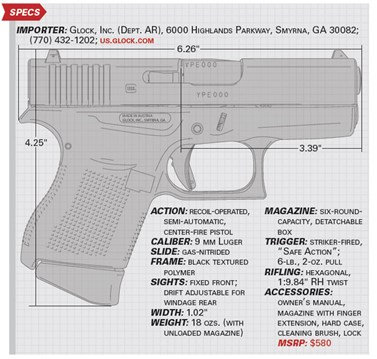 This brings us to the drop-free, fully metal-lined, six-round-capacity, single-stack magazines. Two are provided with the pistol, one with a flat magazine baseplate and one with a slight finger extension. Of all the G43’s features, this is the one most likely to drive some complaints. Why not a seven-round magazine like the Smith & Wesson M&P Shield? Elongating the grip frame to accommodate one or two more rounds would have pushed the grip’s profile out into the same height as the compact models. As it is, using the flat magazine base keeps the grip to the same height as the sub-compact models, like the G26. So why not throw in a magazine plus-one extension? Glock hasn’t done so in the past, so it seems unlikely that it would do so now. The six-round magazines work reliably as they are, so it seems as if Glock will once again rely on aftermarket component makers to embellish its G43 magazines.
This brings us to the drop-free, fully metal-lined, six-round-capacity, single-stack magazines. Two are provided with the pistol, one with a flat magazine baseplate and one with a slight finger extension. Of all the G43’s features, this is the one most likely to drive some complaints. Why not a seven-round magazine like the Smith & Wesson M&P Shield? Elongating the grip frame to accommodate one or two more rounds would have pushed the grip’s profile out into the same height as the compact models. As it is, using the flat magazine base keeps the grip to the same height as the sub-compact models, like the G26. So why not throw in a magazine plus-one extension? Glock hasn’t done so in the past, so it seems unlikely that it would do so now. The six-round magazines work reliably as they are, so it seems as if Glock will once again rely on aftermarket component makers to embellish its G43 magazines.
At The Range
Taking the G43 to the shooting range was a positive experience in which it not only met expectations, but often exceeded them. The pistol is well-balanced for its intended use as a concealable defensive handgun. It certainly isn’t the smallest option on the market, but it proved to be very shootable. The grip was comfortable to hold and the trigger worked smoothly. The magazines locked firmly into place and dropped free when the release was pressed. The slide was easy to manipulate, and all of the controls worked properly. Running the gun felt more like working with a combat handgun than a diminutive back-up gun.
I put the svelte single-stack through its paces with a variety of 9 mm loads. Ammunition ranged from affordable, practice-grade to high-end, defensive loads, standard pressure to +P cartridges, and with bullet weights ranging from 74 to 147 grs. The pistol digested them all without any malfunctions.
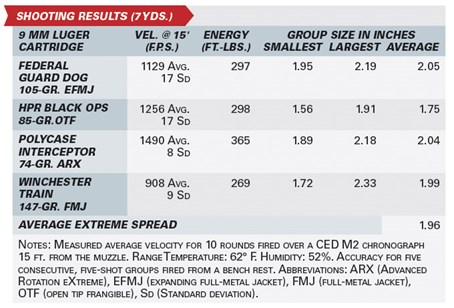 One of the most common standard-velocity 9 mm loads used for practice is the 115-gr. full metal jacket. I fired a fair share of Winchester brand practice-grade ammunition in this configuration and found that it produced a respectable, but not uncomfortable, level of felt recoil. Firing loads with bullets weighing less than 115 grs. generally brought the level of recoil down to a moderate or even modest level. But moving up to +P ammunition produced a stout, even uncomfortable, level of recoil.
One of the most common standard-velocity 9 mm loads used for practice is the 115-gr. full metal jacket. I fired a fair share of Winchester brand practice-grade ammunition in this configuration and found that it produced a respectable, but not uncomfortable, level of felt recoil. Firing loads with bullets weighing less than 115 grs. generally brought the level of recoil down to a moderate or even modest level. But moving up to +P ammunition produced a stout, even uncomfortable, level of recoil.
With regard to accuracy, the G43 produced groups that were on par with the single-stack G42 .380 ACP but not as tight as those of Glock’s double-stack sub-compacts. When bench-resting the thicker pistols, even the hot ones like the Gen4 G33 chambered in .357 SIG, I’ve been able to keep the groups hovering somewhere around 3" at 25 yds. The G43, on the other hand, produced groups ranging from 1.56" to 2.33" with targets set at 7 yds. Although it’s not as tight a shooter as its larger cousins, the G43 is certainly accurate enough for its intended use.
Parting Thoughts
As one of the most highly anticipated pistols in recent memory, the G43 posed some tough design choices for Glock. It had to build a semi-automatic that was fundamentally different enough from previous models to satiate the narrow-framed 9 mm market while preserving the signature shapes that Glock fans have come to expect. The resulting gun does not disappoint.
As a Glock fan, I found that the G43 rang all of the reliability and ease-of-use bells that keep me going back to the company for more. For those unfamiliar with the Glock, this single-stack offers an excellent balance of features and shootability that makes it a viable contender for your holster space. Accessories for the G43 are already shipping and more are on the way.
Glock may be fashionably late to the single-stack 9 mm party, but the company sure did make a grand entrance.













